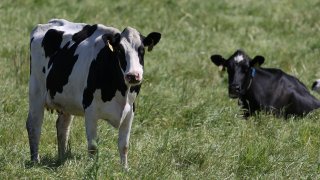
Federal authorities on Friday pledged nearly $200 million in an attempt to control the spread of bird flu on dairy farms. Some of that money would go directly to farms to help them reduce the spread of the virus, cover veterinary costs and compensate farmers who’ve lost milk because of sick cows.
The money is also intended to encourage testing of both dairy cows and the people who work closely with them — a key step, experts said, in understanding the true scope of bird flu, also known as H5N1, across the U.S.
“Incentives work very well to get a better understanding of epidemiology,” said Katelyn Jetelina, who tracks illnesses for a website called “Your Local Epidemiologist.”
Right now, there is no requirement for dairy cows to be tested unless they’re being moved across state lines, according to a recent federal order. Otherwise, the decision is left to farmers.
Get top local stories in Connecticut delivered to you every morning. Sign up for NBC Connecticut's News Headlines newsletter.
So far, only about 80 cows among the 26,000 dairy herds in the U.S. have been tested under the federal order, which went into effect at the end of April, Department of Agriculture Secretary Tom Vilsack said Friday in a media briefing. It was unclear how many of those 80 had tested positive.
As of Friday, 42 herds in nine states — Colorado, Idaho, Kansas, Michigan, New Mexico, North Carolina, South Dakota, Ohio and Texas — had been affected by the outbreak.
U.S. & World
“Those 42 family farm operations are suffering, and we want to make sure we’re there to provide help and assistance,” Vilsack said.
The USDA will offer $98 million to affected farms over the next four months, which could equate to as much as $28,000 per farm, Vilsack said.
Jetelina called the program “a fantastic step” but “way overdue.” The outbreak among dairy cattle was first announced at the end of March.
“The incentive program is a huge leap forward,” especially for smaller farms, said Dr. Keith Poulsen, director of the Wisconsin Veterinary Diagnostic Laboratory. It’s likely not enough, however, for larger farms that could lose upward of $3 million with a bird flu outbreak, he said.
“This is not going to get fixed tomorrow,” he said. But incentives “like this lay the groundwork for it to be better, and it also gives us precedent if and when we deal with the next large outbreak.”
The Department of Health and Human Services will put in an additional $101 million to ramp up monitoring of people who have been exposed to sick animals, contact tracing and genetic testing of the virus to watch for mutations.
Part of those funds will also go toward wastewater surveillance of the virus. The Centers for Disease Control and Prevention is expected to start posting that data publicly as early as Monday, a CDC spokesperson told NBC News.
A separate monitoring system called WastewaterSCAN, which tracks 191 sites in 41 states, is showing high levels of influenza A in the Midwest and Northeast. That’s unusual for mid-May, well past the typical flu season. The bird flu is a type of influenza A virus.
Those findings prompted the WastewaterSCAN researchers to look more closely at wastewater sites in Texas, where it’s believed the bird flu outbreak began.
Further testing indicated that, at the sites in Texas, “what we were seeing was most likely attributable to an H5 influenza virus,” said Marlene Wolfe, an assistant professor of environmental health at Emory University and program director for WastewaterSCAN.
While wastewater testing can detect influenza A, it can’t distinguish whether the virus came from a human or an animal, according to the CDC.
The findings, coupled with recent announcements that fragments of the bird flu virus had been detected in 1 in 5 samples of pasteurized milk, indicate that bird flu may be spreading undetected. Further testing confirmed that the milk, along with other pasteurized dairy products including sour cream and cottage cheese, were safe to eat or drink.
Just one person, a dairy worker in Texas, has tested positive for the virus during the current outbreak. His illness was mild, and his only symptom was pinkeye.
But experts have suggested that other cases could be going undetected. Friday’s incentives announcement included a $75 payment to any farm worker who agrees to give blood and nasal swab samples to the CDC.
Meanwhile, experts said the risk of bird flu spreading among the general public remains low.
“Stay aware, but only let it take up a small part of your brain,” Jetelina said. “There is a good probability that this will fizzle away.”
This story first appeared on NBCNews.com. Read more from NBC News here:



